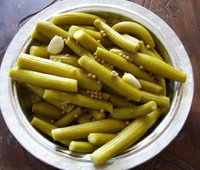
Here is the cover of my new book: 'A Meal for Each Day' My publisher, Yapi Kredi Yayincilik (http://www.ykykultur.com.tr) started a series of '... for each day' series few years ago. First books of the series are for stories, lullabies, kid's games. 'A Meal for Each Day' is pretty much the first book for adults. This book includes 366 meals (including soups, desserts, salads, breads, jams etc) but moreover, it gives short information on the new year celebrations and festivals from different countries from China to Japan, France to Sweden) and customs, celebrations from different cultures. Turkey has a very rich tradition. With this book, I got a chance to look deeper. Just to give an example, in a city called Burdur, there is a carpet weaving tradition. In the old days, it'd take months to weave a big carpet and at the end of the job, women used to come together for a celebration called 'hali dügünü' (carpet wedding) where they ate, sang and danced all together. In Urfa (a souteastern city), there is a bread made with mahalep and some
spices called 'külünçe'. This bread used to be baked before one of the sons of the family is farewelled for the military service. The boy would eat a piece of it then the bread would be hanged on one of the walls. Whenever the family receive a letter from him, after it's read, it'd be attached on that bread. So the bread becomes a frame here. When the boy comes back, he'd be asked to have another piece from the bread and the rest of it is given to the birds. There is so many other traditional information that I found during the research period of this book. So many exciting bits and pieces. I included all the new year celebrations (Nawrouz is another one of it which is celebrated on the 21st of April), religious holidays, seasonal customs etc.
I wanted to add few pictures from the book:

The first one is 'acur tursusu'. Acur is a kind of cucumber which is grown widely in the southeastern part of Turkey. It has a lighter colour and is thinner but longer than cucumber. The Latin name of it is Cucumis anguria and the known English name is 'gherkin'. I took this picture in Mardin, another southeastern city. This is a recipe I got from a family in Mardin. It is a pickle which is made with coriander seeds. A tasty one.

Second one is a 'cacik' recipe. It is made with yoghurt, garlic, salt and cucumbers mostly but this recipe has hazelnuts and is usually made in the Blacksea Region. Hazelnuts are grown widely in the Blacksea Region of Turkey and as you might know, Turkey is number one hazelnut grower in the world and exports hazelnuts to so many countries.

The last one is a special dish which is called 'düdük'. Düdük's dictionary meaning is 'whistle'. This recipe is from the Çanakkale Region. It is a special wedding recipe and it's said that all families include this recipe for their wedding dinners. It is a kind of 'manti' (or ravioli) which is prepared with a similar dough as pasta. It's cut in small squares and given shape like a whistle. The dough is fried then. Afterwords it's cooked with chicken pieces and chicken stock and served in soup plates.
Please feel free to ask about the book and it's content. I'd very much like to see it translated into other languages so let this be the wish for 2006.
* Let me thank my brother Cem and friends Fethiye, Pinar, Asli, Mine, Saikal, Mirace, Basak for their support for the photos. More friends helped with the recipes. I thank them too for their support and friendship!
To order the book:
http://en.eren.com.tr/goster/kitap/kitap.asp?kitap=223957&SID=122818215589

12 comments:
Everything looks fabulous. My mother used to make pickles with mustard and coriander seed! :-) I hope your book gets tranlsated in English. I definitely would buy it.
Zen in the Kitchen I like that. I definitely feel that way about my kitchen. :-)
You are in my "links"
thanks haluk!
*
thank you too vegan mama,
I guess we'll learn something from each other.
tijen
Congrats Tijen, Although more work for you, I think this is an excellent idea and looks like you are already off to a great start. I am amazed at the wealth of dishes from different regions in Turkey. I would have thought of Canakkale area mostly as Aegean but this "Whistle" dish certainly seems different and caught me by surprise. Anything that's like "Manti" is fine by me. :-)
well this 'düdük' (or whistle) is quite something. interestingly, I've seen fried mantis in Burhaniye. You can buy them at the market. the difference is that this manti is empty, with no filling! you can eat it as a snack or cook as the others.. funny eh?
I love to learn about these customs.. thanks for writing!
tijen
Dear Tijen, congratulations on your new blog! I am sure you'll share great things with us as in your other blog. I also bought your most recent book and four of your older ones that I could find while I was in Turkey. I have been literally digging them this past weekend :) They're great. You'll definitely be in my links, too.
thank you yesilerik'cigim,
so you have my books now! good to know that they're traveling around the world, even though their writer is not travelling as much as she used to.. enjoy them and ask whatever you need to ask.
tijen
Tijen, so many people have been asking me if and when this book would be translated into English! I hope, one day...
i'm looking forward to learning more about turkish cuisine and hopefully snag a few recipes. i visited turkey many years ago (yikes, about 15!!!) and still vividly remember the amazing natural beauty of your country from izmir to urfa to istanbul to the ceiling at the local state hospital after foolishly putting some very public and contaminated water to my mouth. are there any dishes, spices or techniques that are unique to turkey?
Dear Tijen,
I received your book (her gune bir yemek) through Yesilerik. She brought from Turkey and sent it to me. I am expecting to get your another books through another friend. I really liked the book especially notes about customs for each day. When I saw 'Dizmana' recipe (my favorite dish was made by my grandma), I showed it to my boyfriend. We were talking this food in previous day and I was really happy to learn how to make it. Your blog in English! Yes... Definitely... You should present the variety of our cuisine and culture to other people :)) Great book :)
hi rae,
I hope you'll come back to turkey!
there is so many new tastes that you can find in different cities. actually they aren't new for the local people but are for the tourists, even though you're turkish. I'll try to mention (and introduce) special dishes, ingredients from different regions of the country but if there is anything that you want to know, pls. feel free to ask.
*
dear ycurl,
dizmana recipe came from our dear friend Mine as I wrote there. I hope you'll find other recipes you enjoy or some new ones that you'll experience. thanks for the link!
tijen
"Gherkin" is kind of a general word that refers to cucumbers that are mostly used for pickling. The name most commonly used in the west for "acur" is "Armenian cucumber." They sometimes show up in grocery stores, but you might not recognized them there because they let them get huge, while in Turkey they usually pick them young and tender for pickling. Tijen, do you ever see acur grown large in Turkey?
Post a Comment